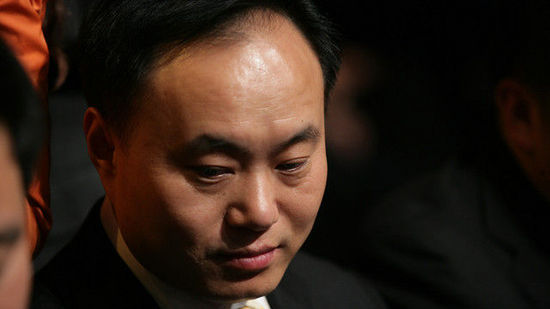 Finally, in mid-January 2013, Suntech’s third “share price of 1 dollar defending war†was declared successful, temporarily retaining the status of listed companies, otherwise it will be forced to go down the market. But at the same time, Suntech has been hit hard on the goodwill. Overseas, investors initiated lawsuits in the United States, suing Shi Zhengrong and his team of senior executives to “smoke Suntech Power, transfer interest to affiliated companies in Asia, and divert $1.68 billion in corporate investmentâ€; domestically, the latest news is: Wuxi National Tax The bureau has already determined that Wuxi Suntech has “missing tax payments†and has cooperated with the Beijing State Taxation Bureau to recover the taxes of Wuxi Suntech and its affiliates in Beijing. The discussion on Suntech’s defeat was very enthusiastic. The international financial crisis, anti-dumping, decision-making mistakes, loose management, and even the “text materials printed for the 10th anniversary celebration†were piled up in the corridor and covered with dust. As a result, don’t forget. Google's labor costs are twice as high as similar companies, 30% of free diners are suspected of rising, and employees can go to their families for ten years... These are not management loopholes? It is easy to kill a tiger, and to restore the true logic and dilemma of corporate decision-making, you find that Shi Zhengrong is not defeated by some micro-governance or management reasons. The defeat of Suntech is a collective slap in the face of Chinese PV companies and local governments. Do you want to expand production capacity? As everyone knows, the “China Solar Army†formed by Suntech Power, Yingli Green Energy, Jiangxi Saiwei, Trina Solar and other companies are all taking radical expansion routes. At all costs, regardless of risk, and do everything possible to increase the production capacity. In addition to listing, bank loans are the main source of funds, and all major banks are deeply involved. Only CDB's credit lines to Jiangxi Saiwei, Trina Solar, and Yingli Green Energy have reached a total of 245 billion yuan. Driven by capital markets and bank funds, Chinese PV companies staged a major leap in capacity. Suntech Power, which is leading the way, has only 400 megawatts in 2007, 1800 megawatts in 2010, and 2,400 megawatts in 2012. Yingli Green Energy is not far behind, and its ability and shipments are close behind.
Finally, in mid-January 2013, Suntech’s third “share price of 1 dollar defending war†was declared successful, temporarily retaining the status of listed companies, otherwise it will be forced to go down the market. But at the same time, Suntech has been hit hard on the goodwill. Overseas, investors initiated lawsuits in the United States, suing Shi Zhengrong and his team of senior executives to “smoke Suntech Power, transfer interest to affiliated companies in Asia, and divert $1.68 billion in corporate investmentâ€; domestically, the latest news is: Wuxi National Tax The bureau has already determined that Wuxi Suntech has “missing tax payments†and has cooperated with the Beijing State Taxation Bureau to recover the taxes of Wuxi Suntech and its affiliates in Beijing. The discussion on Suntech’s defeat was very enthusiastic. The international financial crisis, anti-dumping, decision-making mistakes, loose management, and even the “text materials printed for the 10th anniversary celebration†were piled up in the corridor and covered with dust. As a result, don’t forget. Google's labor costs are twice as high as similar companies, 30% of free diners are suspected of rising, and employees can go to their families for ten years... These are not management loopholes? It is easy to kill a tiger, and to restore the true logic and dilemma of corporate decision-making, you find that Shi Zhengrong is not defeated by some micro-governance or management reasons. The defeat of Suntech is a collective slap in the face of Chinese PV companies and local governments. Do you want to expand production capacity? As everyone knows, the “China Solar Army†formed by Suntech Power, Yingli Green Energy, Jiangxi Saiwei, Trina Solar and other companies are all taking radical expansion routes. At all costs, regardless of risk, and do everything possible to increase the production capacity. In addition to listing, bank loans are the main source of funds, and all major banks are deeply involved. Only CDB's credit lines to Jiangxi Saiwei, Trina Solar, and Yingli Green Energy have reached a total of 245 billion yuan. Driven by capital markets and bank funds, Chinese PV companies staged a major leap in capacity. Suntech Power, which is leading the way, has only 400 megawatts in 2007, 1800 megawatts in 2010, and 2,400 megawatts in 2012. Yingli Green Energy is not far behind, and its ability and shipments are close behind. 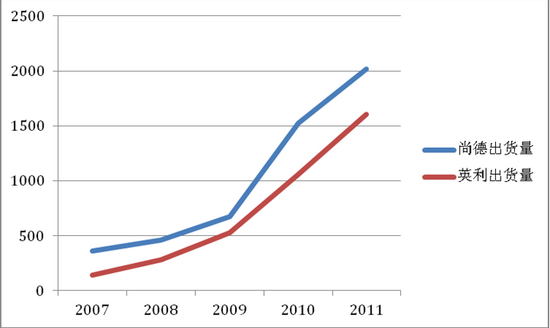 Figure 1 Schematic Power, Yingli Green Energy PV Battery Shipment Schematic (Unit: MW) The first result of aggressive expansion is the high debt ratio, the loss of robustness, and the low risk resistance. For a long time, Suntech’s rigid current liabilities (accounts payable, notes payable, short-term borrowings, non-current liabilities due within one year) have been higher than its available liquid assets (including unrestricted cash, inventory, receivables). Accounts, advance payments), by 2011, the gap has reached 1.265 billion US dollars. Suntech’s approach is to take money from the capital market and borrow money from banks. The three years of financing in 2007, 2008 and 2009 were US$172 million, US$338 million and US$143 million respectively. By 2011, Suntech’s liabilities amounted to $3.584 billion.
Figure 1 Schematic Power, Yingli Green Energy PV Battery Shipment Schematic (Unit: MW) The first result of aggressive expansion is the high debt ratio, the loss of robustness, and the low risk resistance. For a long time, Suntech’s rigid current liabilities (accounts payable, notes payable, short-term borrowings, non-current liabilities due within one year) have been higher than its available liquid assets (including unrestricted cash, inventory, receivables). Accounts, advance payments), by 2011, the gap has reached 1.265 billion US dollars. Suntech’s approach is to take money from the capital market and borrow money from banks. The three years of financing in 2007, 2008 and 2009 were US$172 million, US$338 million and US$143 million respectively. By 2011, Suntech’s liabilities amounted to $3.584 billion. 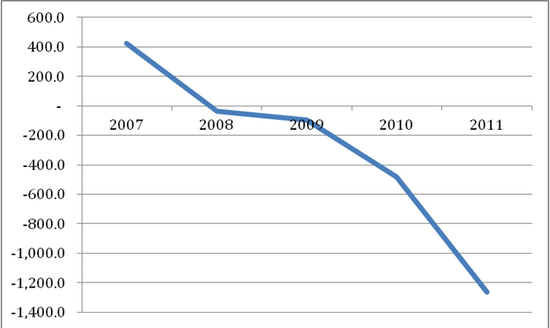 Figure 2 Schematic diagram of Suntech's operating capital gap (available for current assets minus current liabilities) (in millions of US dollars) In the first quarter of 2012, Suntech's short-term loans and long-term loans due within one year totaled more than US$1.56 billion, while Suntech In addition to the $490 million in book cash (220 million of which are still limited due to restrictions), there are only $520 million in "inventory" and $910 million in "accounts receivable". The second evil effect of blindly expanding production capacity is the price decline , which is in response to the phrase "What does the Chinese produce and what should be cheap; what the Chinese want and what is expensive."
Figure 2 Schematic diagram of Suntech's operating capital gap (available for current assets minus current liabilities) (in millions of US dollars) In the first quarter of 2012, Suntech's short-term loans and long-term loans due within one year totaled more than US$1.56 billion, while Suntech In addition to the $490 million in book cash (220 million of which are still limited due to restrictions), there are only $520 million in "inventory" and $910 million in "accounts receivable". The second evil effect of blindly expanding production capacity is the price decline , which is in response to the phrase "What does the Chinese produce and what should be cheap; what the Chinese want and what is expensive." 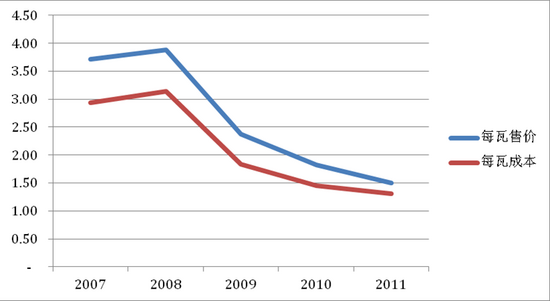 Figure 3 Schematic PV module price unit and cost change diagram Since the fourth quarter of 2008, the demand for solar photovoltaic modules in the international market has dropped significantly. The shipments of Suntech and his "difficult brothers and sisters" are still rising. Looking back, this is a game of fooling people. How much money the European governments subsidize each year depends on the economic situation of their own countries – for example, financial difficulties in the event of economic crisis are less or no subsidies, and have nothing to do with our supply. It’s like a person planning to spend 2 yuan to eat breakfast, you give him two buns, even one yuan. He plans to spend three dollars to eat breakfast, you give him six buns, even five cents. As a result, we saw that Suntech’s sales revenues kept rising and profits continued to fall.
Figure 3 Schematic PV module price unit and cost change diagram Since the fourth quarter of 2008, the demand for solar photovoltaic modules in the international market has dropped significantly. The shipments of Suntech and his "difficult brothers and sisters" are still rising. Looking back, this is a game of fooling people. How much money the European governments subsidize each year depends on the economic situation of their own countries – for example, financial difficulties in the event of economic crisis are less or no subsidies, and have nothing to do with our supply. It’s like a person planning to spend 2 yuan to eat breakfast, you give him two buns, even one yuan. He plans to spend three dollars to eat breakfast, you give him six buns, even five cents. As a result, we saw that Suntech’s sales revenues kept rising and profits continued to fall. 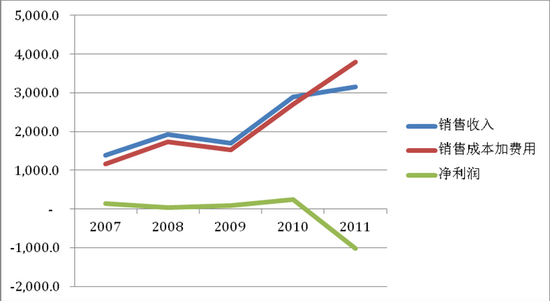 Figure 4 Schneider's performance chart (unit: million US dollars) In September 2012, Suntech announced that it will cut its production capacity by a quarter, from 2,400 megawatts to 1,800 megawatts, and is expected to lay off 1,500 employees. Suntech’s road to capacity expansion is coming to an end. Our question has come: So, should Suntech not expand production capacity? Below we use Suntech as one side, and Yingli as a representative of many Chinese solar energy companies to draw a game (payoff matrix). If both parties do not expand production capacity, their respective incomes are zero. Unilateral expansion of production capacity can achieve five aspects of revenue: cost advantage, market share, land tax policy concessions, capital markets, the bank's additional credit, brand awareness. Assuming that the unilateral expansion party's income is 5 units, the loss of the non-expansion party is 5 units. If both parties expand production capacity, it will inevitably lead to price hikes, product price cuts and tight capital chains. The respective losses are 3 units. Shi Zhengrong and Miao Liansheng, like most entrepreneurs, instinctively will not tolerate competitors unilaterally expanding production capacity. From the perspective of game theory, there is nothing wrong with it: the other party does not expand the energy production, and the already expanded income is 5, otherwise the income is zero, of course, it must be expanded; the other party expands its energy production, and the loss of its own motion is 5, and the loss of catching up is 3, still have to expand. In other words, regardless of the strategy adopted, the expansion of production is a "dominant strategy." If time goes by, Suntech will not let its production capacity stop at 400 MW and sit on Yingli to expand to 1600 MW!
Figure 4 Schneider's performance chart (unit: million US dollars) In September 2012, Suntech announced that it will cut its production capacity by a quarter, from 2,400 megawatts to 1,800 megawatts, and is expected to lay off 1,500 employees. Suntech’s road to capacity expansion is coming to an end. Our question has come: So, should Suntech not expand production capacity? Below we use Suntech as one side, and Yingli as a representative of many Chinese solar energy companies to draw a game (payoff matrix). If both parties do not expand production capacity, their respective incomes are zero. Unilateral expansion of production capacity can achieve five aspects of revenue: cost advantage, market share, land tax policy concessions, capital markets, the bank's additional credit, brand awareness. Assuming that the unilateral expansion party's income is 5 units, the loss of the non-expansion party is 5 units. If both parties expand production capacity, it will inevitably lead to price hikes, product price cuts and tight capital chains. The respective losses are 3 units. Shi Zhengrong and Miao Liansheng, like most entrepreneurs, instinctively will not tolerate competitors unilaterally expanding production capacity. From the perspective of game theory, there is nothing wrong with it: the other party does not expand the energy production, and the already expanded income is 5, otherwise the income is zero, of course, it must be expanded; the other party expands its energy production, and the loss of its own motion is 5, and the loss of catching up is 3, still have to expand. In other words, regardless of the strategy adopted, the expansion of production is a "dominant strategy." If time goes by, Suntech will not let its production capacity stop at 400 MW and sit on Yingli to expand to 1600 MW!  Do you want to have your own polysilicon capacity? There is also an important class of players in the aforementioned "Foolish Man Game", which is the international crystalline silicon production giant. Their products are of high quality, low energy consumption and low cost (the cost of solar grade products is about $30/kg). In the past, almost all of the raw materials needed for Chinese PV companies came from overseas. With the "China Solar Legion" rushing, the price of crystalline silicon has climbed to more than $400 per kilogram. Shi Zhengrong, who was born in the class, would naturally foresee this situation. Suntech rushed to a 10-year procurement contract with suppliers before the price of raw materials soared, locking a considerable portion of raw material supply at a price of 40 US dollars per kilogram. It's like driving a head into an air-conditioned window in a hot weather. Although it is still hot, the possibility of heat stroke is greatly reduced. But unfortunately it happened. When the price of polysilicon doubles, it is impossible for PV companies to pass all the costs to users, and the profit margin is greatly reduced. When China's polysilicon production capacity first appeared, when it had the advantage of technology and cost, the international companies that had earned a lot of money had begun to maliciously suppress prices. Due to the economic downturn in European countries, the price reduction of raw materials became the reason for lowering the price of the products. . The result is that the profit margins of PV companies are further compressed. Suntech, which has long-term contracts with suppliers, is even more unlucky. In the first half of 2012, polysilicon prices have fallen to $23.6 per kilogram, and Suntech has to purchase $40 per kilogram by contract. Despite the difficult negotiations and compensation of hundreds of millions of dollars, Suntech canceled some of the contracts, but the high-priced raw materials, semi-finished products and finished products in stocks face huge impairment losses. In the event of a bankruptcy of Chinese manufacturing companies, polysilicon prices will surely skyrocket again. Today, people have discovered that solar energy companies that wear "high-tech" and "green" aura are just "polysilicon processing plants." Since the raw materials are subject to the tragic situation of people, why not build or participate in polysilicon production plants? Some media believe that Shi Zhengrong's determination and investment in establishing its own polysilicon production capacity is not enough. He believes that this is an important reason for Suntech's situation today. But not also. As a photovoltaic expert from the class, Shi Zhengrong has a deeper understanding of polysilicon production technology than several other bosses. If investing in polysilicon manufacturing, Suntech will be even worse, and Yingli's polysilicon route just proves this. In 2008, Yingli plans to invest 12 billion yuan in the "Fine Silicon" (Fine Silicon) officially launched. The first phase of the 3,000-ton polysilicon production line was completed in 2010. Known as "using the new silane process, greatly reducing energy consumption and pollution", the cost per kilogram can be reduced to 22 US dollars after production! Yingli executives also announced that the production capacity of Liujiu Silicon will reach 18,000 in 2013. For a time, the remarks of the beautiful people from all walks of life were endless, and even the outgoing Jiang Zemin personally went to the six or nine silicon industry inspection. Less than a year, the silicon industry has its original shape: the technology is not mature enough, the cost is as high as 60 US dollars per kilogram, and the production line condition is continuously outputting dozens of tons per quarter, and the quality is difficult to guarantee. In FY2011, Yingli made a provision for impairment of 2.275 billion yuan (near the investment amount of the first phase) for the “Six-nine Silicon Industryâ€, announcing the complete failure of the project.
Do you want to have your own polysilicon capacity? There is also an important class of players in the aforementioned "Foolish Man Game", which is the international crystalline silicon production giant. Their products are of high quality, low energy consumption and low cost (the cost of solar grade products is about $30/kg). In the past, almost all of the raw materials needed for Chinese PV companies came from overseas. With the "China Solar Legion" rushing, the price of crystalline silicon has climbed to more than $400 per kilogram. Shi Zhengrong, who was born in the class, would naturally foresee this situation. Suntech rushed to a 10-year procurement contract with suppliers before the price of raw materials soared, locking a considerable portion of raw material supply at a price of 40 US dollars per kilogram. It's like driving a head into an air-conditioned window in a hot weather. Although it is still hot, the possibility of heat stroke is greatly reduced. But unfortunately it happened. When the price of polysilicon doubles, it is impossible for PV companies to pass all the costs to users, and the profit margin is greatly reduced. When China's polysilicon production capacity first appeared, when it had the advantage of technology and cost, the international companies that had earned a lot of money had begun to maliciously suppress prices. Due to the economic downturn in European countries, the price reduction of raw materials became the reason for lowering the price of the products. . The result is that the profit margins of PV companies are further compressed. Suntech, which has long-term contracts with suppliers, is even more unlucky. In the first half of 2012, polysilicon prices have fallen to $23.6 per kilogram, and Suntech has to purchase $40 per kilogram by contract. Despite the difficult negotiations and compensation of hundreds of millions of dollars, Suntech canceled some of the contracts, but the high-priced raw materials, semi-finished products and finished products in stocks face huge impairment losses. In the event of a bankruptcy of Chinese manufacturing companies, polysilicon prices will surely skyrocket again. Today, people have discovered that solar energy companies that wear "high-tech" and "green" aura are just "polysilicon processing plants." Since the raw materials are subject to the tragic situation of people, why not build or participate in polysilicon production plants? Some media believe that Shi Zhengrong's determination and investment in establishing its own polysilicon production capacity is not enough. He believes that this is an important reason for Suntech's situation today. But not also. As a photovoltaic expert from the class, Shi Zhengrong has a deeper understanding of polysilicon production technology than several other bosses. If investing in polysilicon manufacturing, Suntech will be even worse, and Yingli's polysilicon route just proves this. In 2008, Yingli plans to invest 12 billion yuan in the "Fine Silicon" (Fine Silicon) officially launched. The first phase of the 3,000-ton polysilicon production line was completed in 2010. Known as "using the new silane process, greatly reducing energy consumption and pollution", the cost per kilogram can be reduced to 22 US dollars after production! Yingli executives also announced that the production capacity of Liujiu Silicon will reach 18,000 in 2013. For a time, the remarks of the beautiful people from all walks of life were endless, and even the outgoing Jiang Zemin personally went to the six or nine silicon industry inspection. Less than a year, the silicon industry has its original shape: the technology is not mature enough, the cost is as high as 60 US dollars per kilogram, and the production line condition is continuously outputting dozens of tons per quarter, and the quality is difficult to guarantee. In FY2011, Yingli made a provision for impairment of 2.275 billion yuan (near the investment amount of the first phase) for the “Six-nine Silicon Industryâ€, announcing the complete failure of the project. 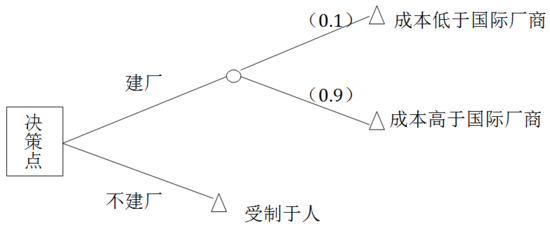 As can be seen from the decision tree above, the capacity of polysilicon not built by itself will be subject to the passive state of people. The cost of producing qualified products for investment in construction plants is only 10% lower than that of international manufacturers. If the production cost of polysilicon is high, the cost of producing photovoltaic modules is inevitably high, and whoever uses them will be at a disadvantage in the market competition. After turning a big circle, I have to turn to international manufacturers to purchase. At the beginning, Miao Liansheng, who was "innocent and fearless", would not have expected that the probability of self-built factories being lower than the international advanced level would be so small. Looking back, because of Shi Zhengrong's understanding of polysilicon production technology, Suntech did not make great efforts to establish its own polysilicon production capacity, avoiding billions of investment losses. The pattern is inherently flawed, and the more the corner is overtaken, the more severe it is. The failure of Suntech Power and Yingli Green Energy naturally has its own reasons. There are problems with technology, market, management and even the mentality of business leaders. This is beyond doubt, but this is not the main reason why China's PV industry is in deep trouble. One of the main reasons is that "the two are outside." At the beginning of the climate of China's photovoltaic army, 99% of China's PV products were sold to the European market, and almost all of its core raw material polysilicon came from international manufacturers. Many people of insight have doubts about "two heads outside", but "Shi Zhengrong" believes that expanding production capacity will win the initiative. Some media believe that small and medium-sized PV companies will be more difficult to survive, but it is not. Small factories engaged in “processing of materials†in the “development zone†simple factory building do not have a heavy debt burden, and they do not have to care about fluctuations in raw materials and product prices. Big deal, pull the electric gate, the door does not have to lock, because there is nothing to steal! In addition, there are two dead spots in Chinese PV companies: demand is non-rigid and there is no core technology. Photovoltaic cells are not necessities, and their markets are completely subsidized by governments. Even from the perspective of green environmental protection, there are alternatives such as wind power, hydropower, tidal, geothermal and solar thermal utilization. When the buyer holds the attitude of "Your things we don't want, you love to sell or not sell is the price", the seller's huge production capacity is not wealth, but burden. It can be said that China's PV companies, governments at all levels and financial institutions have made mistakes in the general direction! In this context, the main reason for Suntech's failure is not Shi Zhengrong's personal decision-making mistakes, related transactions, and asset transfer. When the industry's position and business model have been congenitally placed, Shi Zhengrong has even made various "dominant strategies". Nor can we get rid of the fate of failure, and the more we win, the worse we will lose. I don't know from what year, the "curve overtaking theory" is popular among Chinese entrepreneurs.
As can be seen from the decision tree above, the capacity of polysilicon not built by itself will be subject to the passive state of people. The cost of producing qualified products for investment in construction plants is only 10% lower than that of international manufacturers. If the production cost of polysilicon is high, the cost of producing photovoltaic modules is inevitably high, and whoever uses them will be at a disadvantage in the market competition. After turning a big circle, I have to turn to international manufacturers to purchase. At the beginning, Miao Liansheng, who was "innocent and fearless", would not have expected that the probability of self-built factories being lower than the international advanced level would be so small. Looking back, because of Shi Zhengrong's understanding of polysilicon production technology, Suntech did not make great efforts to establish its own polysilicon production capacity, avoiding billions of investment losses. The pattern is inherently flawed, and the more the corner is overtaken, the more severe it is. The failure of Suntech Power and Yingli Green Energy naturally has its own reasons. There are problems with technology, market, management and even the mentality of business leaders. This is beyond doubt, but this is not the main reason why China's PV industry is in deep trouble. One of the main reasons is that "the two are outside." At the beginning of the climate of China's photovoltaic army, 99% of China's PV products were sold to the European market, and almost all of its core raw material polysilicon came from international manufacturers. Many people of insight have doubts about "two heads outside", but "Shi Zhengrong" believes that expanding production capacity will win the initiative. Some media believe that small and medium-sized PV companies will be more difficult to survive, but it is not. Small factories engaged in “processing of materials†in the “development zone†simple factory building do not have a heavy debt burden, and they do not have to care about fluctuations in raw materials and product prices. Big deal, pull the electric gate, the door does not have to lock, because there is nothing to steal! In addition, there are two dead spots in Chinese PV companies: demand is non-rigid and there is no core technology. Photovoltaic cells are not necessities, and their markets are completely subsidized by governments. Even from the perspective of green environmental protection, there are alternatives such as wind power, hydropower, tidal, geothermal and solar thermal utilization. When the buyer holds the attitude of "Your things we don't want, you love to sell or not sell is the price", the seller's huge production capacity is not wealth, but burden. It can be said that China's PV companies, governments at all levels and financial institutions have made mistakes in the general direction! In this context, the main reason for Suntech's failure is not Shi Zhengrong's personal decision-making mistakes, related transactions, and asset transfer. When the industry's position and business model have been congenitally placed, Shi Zhengrong has even made various "dominant strategies". Nor can we get rid of the fate of failure, and the more we win, the worse we will lose. I don't know from what year, the "curve overtaking theory" is popular among Chinese entrepreneurs. Curved overtaking is essentially a speculation. The late movers believe that they can take advantage of the opportunity of the pioneers to embark on the "detour" or "evil road" and take shortcuts to surpass each other. But they did not know how much research and trial and error the first mover had made, and chose the road to bypass the traps and mines. In the "The Analects of Confucius", Confucius said: "There is no way to destroy the Ming and the dynasty," meaning that the person who shuns the Ming and Qing dynasty will never take a shortcut. “It’s not easy to walk†seems to be slow. It’s not easy to catch up with the opponent, but it avoids many unnecessary risks.
Seeing the subsidies of the European government to expand production capacity, the price of polysilicon is high, and the factory is built. It is rushed to the scale, and puts the posture of “making it for you if you are willing to buy itâ€... These are the attitudes of the overtaking of the curve. Performance and practice. And it is it that harms Suntech.
Expanded metal also named diamond metal mesh, that uses the high quality low carbon steel plate, aluminium plate, stainless steel plate, galvanized steel plate, nickel plate, titanium plate, lead plate and so on be punched to mesh. Expanded Metal Mesh including: standard expanded metal, flattened expanded metal, architectural expanded metal, micro expanded metal, ribbon expanded metal, custom fabricated expanded metal.
The surface treatment of expanded metal sheet: PVC coated, galvanized, anodizing, antirust painted
The material: high quality low carbon steel plate, aluminium plate, stainless steel plate, galvanized steel plate, nickel plate, titanium plate, lead plate
The uses of expanded metal panel: Filter Mesh, Filter Cartridge, platforms, catwalks, walkways, decorative building, rail enclosures, conveyors, etc
The advantages of expanded metal:
beautiful, strong and durable
uniform mesh, smooth surface, high friction coefficient and strength
easy cutting and process
The mesh is firm
shockproof
resistant to high temperature
no deformation, no rust
non-toxic and tasteless
easy to use
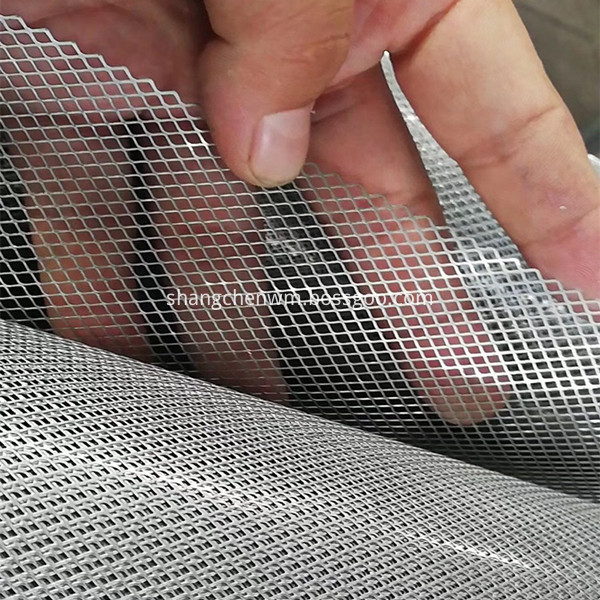
Expanded Metal
Expanded Metal,Expanded Metal Mesh,Stainless Steel Expanded Metal Mesh,Expanded Metal Mesh
ANPING COUNTY SHANGCHEN WIREMESH PRODUCTS CO.,LTD , http://www.scwiremesh.com